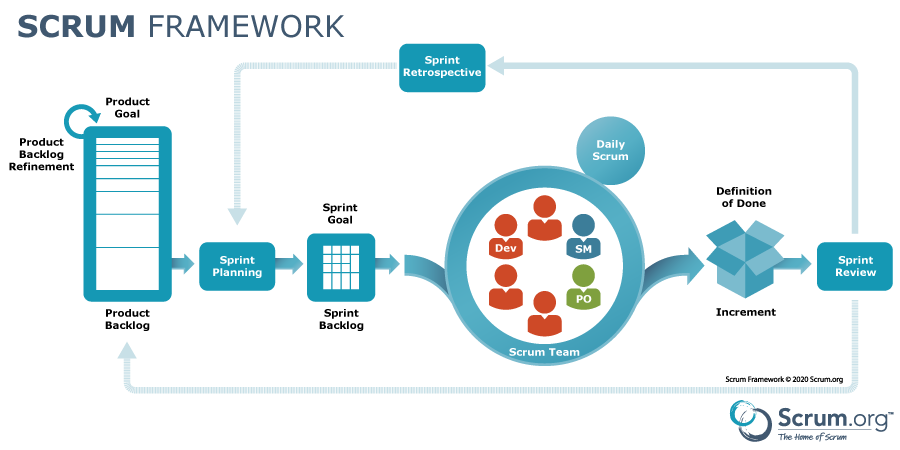What is Scrum Project Management?

Scrum is a framework for developing and sustaining complex products. This Guide contains the definition of Scrum. This definition consists of Scrum’s roles, events, artifacts, and the rules that bind them together. Ken Schwaber and Jeff Sutherland developed Scrum; the Scrum Guide is written and provided by them. Together, they stand behind the Scrum Guide.
In a survey, 52% of respondents said they were not happy with the current project management in their company.
What is Scrum Project Management?

Image Credit: https://www.scrum.org
The Scrum Guide was first introduced to the world in 1995 as a better way of team collaboration for solving complex problems. The Scrum framework is fairly simple being made up of a Scrum Team consisting of a Product Owner, a Scrum Master and Developers, each of which have specific accountabilities.
The Scrum Team takes part in five events and produces three artifacts. Scrum co-creators Ken Schwaber and Jeff Sutherland wrote and maintain The Scrum Guide, which explains Scrum clearly and succinctly. The guide contains the definition of Scrum, describing the Scrum accountabilities, events, artifacts and the guidance that binds them together.
Scrum project management is inspired by a scrum in the sport of rugby. In rugby, the team comes together in what they call a scrum to work together to move the ball forward. In this context, Scrum is where the team comes together to move the product forward.
Scrum is an empirical process, where decisions are based on observation, experience and experimentation. Scrum has three pillars: transparency, inspection and adaptation. This supports the concept of working iteratively. Think of Empiricism as working through small experiments, learning from that work and adapting both what you are doing and how you are doing it as needed.
Scrum is an empirical process, where decisions are based on observation, experience and experimentation. Scrum has three pillars: transparency, inspection and adaptation. This supports the concept of working iteratively. Think of Empiricism as working through small experiments, learning from that work and adapting both what you are doing and how you are doing it as needed.
One critical Scrum Team characteristic that binds all of the elements together is Trust. If Trust is not present on a Scrum Team, there will likely be tension and bottlenecks in the way of getting work done. The Scrum Values are also critical for Scrum Teams to adhere to as they help to guide how you work and drive trust. The Scrum Values of Courage, Focus, Commitment, Respect, and Openness, are all important elements that Scrum Team members must consider when working together. The Scrum Values are particularly important in environments where experimentation is core to making progress.
Courage to bring up conflicts among the team to work to resolve them together; Openness to embrace each others ideas; Focus on the work they are doing and be careful not to be distracted; Commitment to the creation of a Done Increment; Respect for all of the members of the Scrum Team and their ideas as well.

The Scrum Values, Image Credit: https://www.scrum.org
The scrum environment:
- Increments of valuable work are delivered in short cycles of one month or less, which are called Sprints. Ongoing feedback occurs during the Sprint, allowing for inspection and adaptation of the process and what will be delivered.
- The Scrum Team has a Scrum Master, a Product Owner and Developers, who are accountable for turning the selection of the work into an Increment of value during a Sprint.
- The Scrum Team and other members of their organization, business, users or customer-base known as stakeholders, inspect the results of the Sprint and adjust for the next one.
The Scrum Team
The fundamental unit of Scrum is a small team of people, a Scrum Team. The Scrum Team consists of one Scrum Master, one Product Owner, and Developers. Within a Scrum Team, there are no sub-teams or hierarchies. It is a cohesive unit of professionals focused on one objective at a time, the Product Goal.
The Scrum Team is small enough to remain nimble and large enough to complete significant work within a Sprint, typically 10 or fewer people. In general, we have found that smaller teams communicate better and are more productive. If Scrum Teams become too large, they should consider reorganizing into multiple cohesive Scrum Teams, each focused on the same product. Therefore, they should share the same Product Goal, Product Backlog, and Product Owner.
The Scrum Team is responsible for all product-related activities from stakeholder collaboration, verification, maintenance, operation, experimentation, research and development, and anything else that might be required. They are structured and empowered by the organization to manage their own work. Working in Sprints at a sustainable pace improves the Scrum Team’s focus and consistency.
The entire Scrum Team is accountable for creating a valuable, useful Increment every Sprint. Scrum defines three specific accountabilities within the Scrum Team: the Developers, the Product Owner, and the Scrum Master.
What is a Scrum Master?
The Scrum Master is accountable for establishing Scrum. They do this by helping everyone understand Scrum theory and practice, both within the Scrum Team and the organization while serving the Scrum Team as well as the larger organization.
The role of the Scrum Master has a lot of layers and facets to it. While building awareness around Scrum and enabling greater agility, Scrum Masters also need soft skills that are needed to coach and mentor members of the Scrum Team and others in the organization. Scrum Masters are accountable for helping their teams succeed, and that often means offering them assistance in groups or on a one-on-one basis. They may facilitate exercises, give guidance or help people come to conclusions on their own. Not everyone has the skills necessary to be a Scrum Master, and that is important to keep in mind when considering this career path.
The Scrum Master:
helps the Scrum Team:
- By coaching the team members in self-management and cross-functionality
- Focus on creating high-value Increments that meet the Definition of Done
- Influence the removal of impediments to the Scrum Team’s progress
- Ensure that all Scrum events take place and are positive, productive, and kept within the timebox.
helps the Product Owner:
- Find techniques for effective Product Goal definition and Product Backlog management
- Provide ways for the Scrum Team to understand the need for clear and concise Product Backlog items
- Establish empirical product planning for a complex environment
- Facilitate stakeholder collaboration as requested or needed
supports the Organization:
- By Leading, training and coaching them in their Scrum adoption
- By helping employees and stakeholders understand and instill an empirical approach for complex work
- Remove barriers between stakeholders and Scrum Teams
To be successful, the Scrum Master must wear different hats that depend on the situation or challenge the team is facing.

In any given situation, a Scrum Master utilizes their important soft skills to act as a Servant Leader, Facilitator, Coach, Manager, Mentor, Teacher, Impediment Remover or Change Agent, depending on the situation at hand. For example, the Scrum Master may facilitate a new activity to help the Scrum Team run their Sprint Retrospective in a way that encourages more participation from the group; they may coach a new Developer who needs some guidance on how to work with their new team; they also may take the teacher stance and teach team members a new technique they learned to handle conflicts with the team.
What is a Product Owner?
A Product Owner is accountable for maximizing the value of the product resulting from the work of the Scrum Team. How this is done may vary widely across organizations, Scrum Teams and individuals.
The Product Owner provides clarity to the team about a product’s vision and goal. the Product Owner provides clarity to the team about a product’s vision and goal.
The Product Owner is accountable for effective Product Backlog management, which includes:
- Developing and explicitly communicating the Product Goal
- Creating and clearly communicating Product Backlog Items
- Ordering Product Backlog Items
- Ensuring that the Product Backlog is transparent, visible and understood
The Product Owner may do this work or delegate the responsibility to others on the Scrum Team. Regardless of who does the work, the Product Owner remains accountable for it being accomplished.
If someone in the organization wants a change in the Product Backlog, they need to discuss this with the Product Owner and try to convince them. But at the end of the day, the Product Owner makes the decision. The Product Owner should also be getting feedback from customers on the product.
What is a Developer?
A Developer is not necessarily a software developer. They can focus on any type of product work whether software or not and any aspect of helping to design, build, test or ship the product. The specific skills needed by the Developers are often broad and will vary based on the type of work they are doing. However, the Developers are always accountable for:
- Creating a plan for the Sprint, the Sprint Backlog
- Instilling quality by adhering to a Definition of Done
- Adapting their plan each day toward the Sprint Goal
- Holding each other accountable as professionals
Developers may also have instances where they need to embrace such practices as facilitation, mentoring, teaching and coaching.
What is a Sprint?
Sprints are the heartbeat of Scrum, where ideas are turned into value. The Sprint is the Scrum event that encompasses all of the other Scrum events.
They are fixed length periods of work that last one month or less to create consistency and ensure short iterations for feedback in order to inspect and adapt both how work is done and what is being worked on. If cycles are longer, then the spirit of frequent feedback cycles can be lost. Longer Sprint may also get too complex and may increase risk. A new Sprint starts immediately after the conclusion of the previous Sprint.
Sprints enable predictability by ensuring that the Scrum Team inspects and adapts toward the Product Goal and Sprint Goal each Sprint:
- Product Goal– The Product Goal describes a future state of the product which can serve as a target for the Scrum Team to plan against. The Product Goal is in the Product Backlog. The rest of the Product Backlog emerges to define “what” will fulfill the Product Goal. The Product Goal is the long-term objective for the Scrum Team. They must fulfill (or abandon) one objective before taking on the next.
- Sprint Goal – The Sprint Goal is the single objective for the Sprint. Although the Sprint Goal is a commitment by the Developers, it provides flexibility in terms of the exact work needed to achieve it. The Sprint Goal also creates coherence and focus, encouraging the Scrum Team to work together rather than on separate initiatives.
Sprints should be one month in length or less. Shorter Sprints generate more learning cycles and limit risk to a smaller time frame. Each Sprint may be considered a short stretch of work.
Empiricism is the most important practice for you and your Scrum Team to embrace during the Sprint. There is a lot unknown in complex environments. By embracing empiricism your team will learn by doing and will continue to improve as you navigate complex work. Forward looking decisions can only be made by the Scrum Team based on what has already happened. Various practices exist to forecast progress, like burn-downs, burn-ups, or cumulative flows. While proven useful, these do not replace the importance of empiricism.
Conclusion
Conclude
References
https://www.scrum.org/learning-series/what-is-scrum
Last Updated on 1 March 2024 by Tuomas Data
